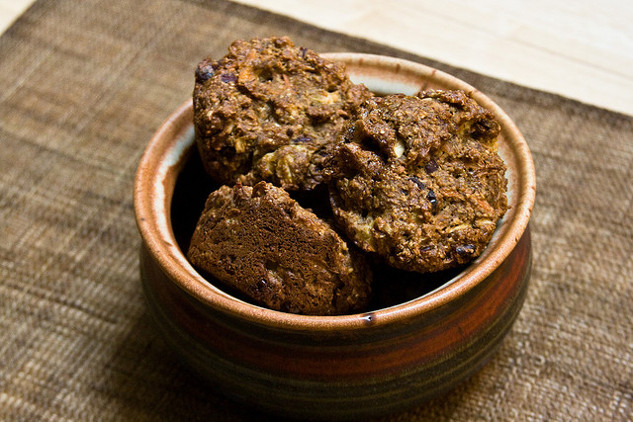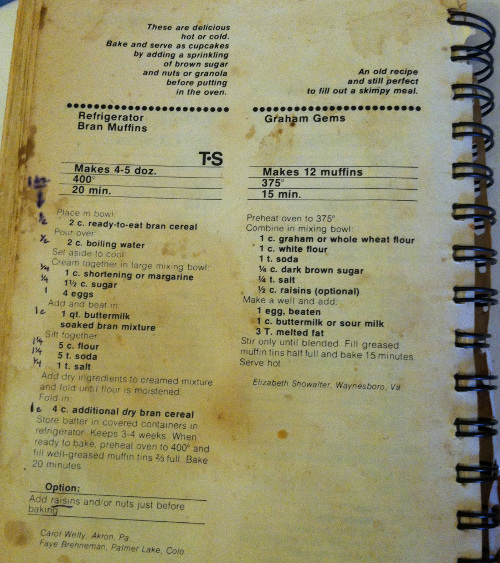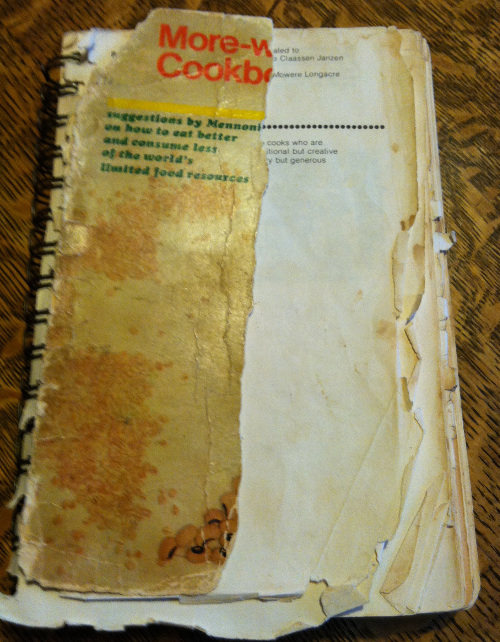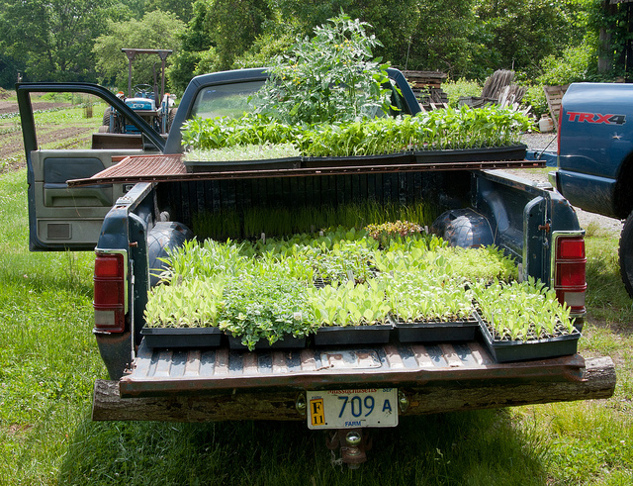Life-Changing Cookbooks: More-with-Less
Paste's column on the cookbooks that shape who we are
Food Features cookbooksMy cells have recorded fringed pie crusts turning golden under heat, flaking under forks. One-pot meals, emanating deep smells from slow cookers, remain in my lungs. Family suppers are my bones, potluck dinners, my joints—food almost never eaten alone, food as a way of knowing who we are together.
Blessed are the peacemakers, my Mennonite upbringing still whispers to me, for they will grow large gardens, preserve produce in glass jars, and dog-ear their More-with-Less cookbooks. Food is patient. Food is kind. It does not envy, it does not boast, it is not proud. Love your neighbor with your casserole.
From this tradition—before simple was fashionable, before farm-to-table inspired gourmet chefs, before I knew that the young soybeans we steamed from our farm field were called edamame—Doris Janzen Longacre wrote the More-with-Less cookbook. Published in 1976, More-with-Less has provided a culinary modus operandi for several generations of Mennonites and other world-changers.
We strive to be, as Longacre describes in the book’s dedication to her mother and mother-in-law, cooks who are “traditional but creative, thrifty but generous.” In keeping with Mennonite ethics of community, peace, and social justice, More-with-Less is a map for eating well at home, using straightforward recipes and ingredients that minimize harm to the planet’s social and environmental systems. Along with four-part a cappella singing, More-with-Less became a staple of North American Mennonite culture.
Mom reminds me of the “More with Less” 1970’s life hacks, like Refrigerator Bran Muffins, which make a vat of batter that you can scoop from the fridge to bake a hot dozen in no time.
Plagued by asthma as a child, Longacre and her family moved, on the doctor’s recommendation, from a Kansas farm to Tucson, Arizona. In the Sonoran Desert, her health improved, and she fed a budding love for cooking, shadowing her mom in the kitchen. As an adult, Longacre and her husband lived in Vietnam and Indonesia on service assignments through Mennonite Central Committee (MCC), embracing satay and curry and nasi goreng. They returned to work for MCC in Akron, Pennsylvania, with their two daughters.
Doris Janzen Longacre attended the church in Akron that raised me, although I never met her—our lifetimes barely overlapped. When I leaf through the More-with-Less, I see names of people I know who contributed and tested recipes. The book includes many voices, with Longacre adding nutrition information and a global perspective in harmony with the food.
Focused on the essentials, Doris Janzen Longacre kept a personal list of reminders to live fully, where she declares that life is too short not to hug your spouse and kids every day, write to your parents, and immerse in nature, and includes my favorites, “life is too short to keep all your floors shiny,” and “life is too short to care whether purses match shoes or towels match bathrooms.” She died of cancer at age thirty-nine.
“Put dismal thoughts aside then,” Longacre writes at the beginning of More-with-Less, “because this book is not about cutting back. This book is about living joyfully, richly, and creatively,” In the original edition, these words appear beside a floating, black-and-white chocolate cupcake, photographed with high contrast so that its light and shadows appear yin and yang.

Robert Judge CC BY
I call my mom. She has not worn a conservative Mennonite covering and cape dress since heading to college. She and my dad raised us in a blue-jeans-wearing, world-traveling Mennonite church, which we have all since outgrown in our own ways, but still carry with us. Her copy of More-with-Less disintegrates from use, with “very good” scripted above her successes.
“It kind of replaced the Mennonite Community Cookbook,” she explains, “where everything was cooked in lard.” I nod into the phone, knowing that Mom and I both still use the Mennonite Community for our best desserts.
Mary Emma Showalter Eby, author of the 1950 Mennonite Community Cookbook, gave Longacre her blessing, passing the apron. In the foreword for More-with-Less, Eby astutely predicts, “This cookbook will appeal most to young homemakers whose lifestyles are open to change, and whose desire for variety and creativity will lend enchantment for trying new recipes.
“That was the hand-off,” Mom says.
“Perhaps this is as it should be,” Eby continues, “since they are most responsible for the food habits for the next generation.”
My copy of More-with-Less, handed down from my mother-in-law when she updated to a pristine revision, shed the back half of its index, requiring me to flip through the vegetable section looking for Skillet Italian Zucchini, although I could zip directly to Crunchy Granola.
Mom reminds me of the More with Less 1970’s life hacks, like Refrigerator Bran Muffins, which make a vat of batter that you can scoop from the fridge to bake a hot dozen in no time. Most recipes make quantities large enough to eat half for supper tonight and leftovers the next day. Longacre marked the handier recipes with TS, Time Saver, for the busy household. The cookbook also includes instructions for homemade laundry detergent, which I’ve never made, but feel I probably should, since the Mennonite obligation to live well also feeds my overactive conscience.

At Doris Janzen Longacre’s alma mater, Goshen College, thirty-five years after she graduated, I perused the cafeteria salad bar. Probably wearing baggy overalls and a bandana do-rag-style over my short hair, I plucked a whole zucchini from the salad bar décor and thunked it onto my lunch tray, claiming it for later. A shaggy guy—under-bathed and well-built—appeared at my shoulder.
“Are you gonna make zucchini bread with that?” he asked quietly.
I could perform organic chemistry experiments and bake shoo-fly pie, but I shrugged and said, “I’ve never made zucchini bread,” which was true.
He followed my zucchini and me home to the More-with-Less. We baked.
“Some couples would not call it a romantic encounter,” Longacre writes about late summer evenings canning cucumbers with her husband, “but we liked it.”
The shaggy guy, my eventual husband, and I had both grown up eating More-with-Less. Our frugal personalities flourished on recipes that made one pound of ground beef feed a family for several meals. He impressed me early in our relationship by producing Whole Wheat Buttermilk Pancakes from memory. On a budget, I cooked Sweet and Sour Lentils, Baked Lentils with Cheese, Curried Lentils, and Basic Lentil Stew, congratulating myself on my diverse menus. We were beginning our nascent adulthoods, learning how we might cook and eat in the world.

Many of us are still searching for how to eat well. In his book, The Third Plate, farm-to-table chef Dan Barber suggests that while we have increasing options to purchase sustainably-raised food, we have not revised the way we eat.
“How do we eat?” Barber writes, “Mostly with a heavy hand. For a long time, the prototypical American meal had featured a choice cut—like a seven-ounce steak or a boneless, skinless chicken breast or a fillet of salmon—and a small side of vegetables or grains.” He proposes that we redesign our meals to have a different architecture, with structural vegetables and meat as trim.
After college, I moved to Tucson for one year of Mennonite Voluntary Service, not knowing it was Longacre’s hometown, not thinking about hippies or sustainability, just struggling to draft the architecture of my own life. I bicycled ten miles each way to work from the community house where I lived with other volunteers—a German guy and two married Canadians. I didn’t need to bring the More-with-Less; the household already had it.
Beginning the year as complete strangers, we juggled our modest monthly food budget, eating primarily vegetarian, and often from the community garden that we started with the neighborhood. My German housemate baked huge multigrain bread loaves. The Canadian couple created intricate chopped salads. We—sometimes awkwardly—invented our household for a year, relying on shared food rituals that trumped our individual differences.
Dan Barber laments the absence of a robust cultural tradition of food in the United States. He writes, “The curse is that, without a golden age in farming, and with a history that lacks a strong model for good eating, the values of true sustainability don’t penetrate our food culture.” Perhaps, though, some seemingly quirky subcultures, such as Mennonite volunteers, do offer a patchwork history for today’s cooks who seek responsible, delicious food. Perhaps this food culture is creative and generous enough to share, to write into the bodies of all good eaters.
I can still smell the homemade play-dough—as salty and bright as my childhood—arriving warm under my hands and food-color tinted onto our old oak table with four legs curving downward to carved paws.
“Poor Man’s Lobster Thermidor,” my mom says on the phone, “I used to make that.”
“I have no memory of that.”
“It was just white fish,” she says, as I make a mental note to try it. She is flipping through the cookbook, transported by remembered tastes and smells back to our large farm kitchen, the swimming-hard feeling of farming and parenting two young girls.
I do remember casseroles based on noodles or tortillas or rice, with vegetables and cheese, and some chicken or meat. I remember Honey-Baked Chicken sizzling in a honey-mustard-curry sauce that we scraped from the pan to drizzle over rice. Skillet Italian Zucchini used satisfying numbers of proliferating garden squash and, in true More-with-Less fashion, tasted better than expected from the sum of its few parts. I can still smell the homemade play-dough—as salty and bright as my childhood—arriving warm under my hands and food-color tinted onto our old oak table with four legs curving downward to carved paws.
While Longacre’s cookbook was selling beyond expectations, my parents were busting their butts on my dad’s family farm, which he farmed with his best childhood friend. In mid-summer, they’d drive the blue Ford pickup into the yard, loaded with one hundred dozen ears of sweet corn. Friends and family—hippie-types in short cutoff shorts and Mennonite aunts and grandmas with their small-print dresses draping between spread knees—all spread out in the huge maple tree’s shade, husking ears and cutting corn from the cobs for freezing.
My memories are the long tracks of cut-off corn, reeled from paring knives and snatched into my mouth—all flavor and fullness. My mom’s memories are one whole year’s work flattened by hail, a thumb nearly lost to a potato harvester named Grace, struggling in context of the 1980’s farm crisis. We lived more with less.

Dwight Sipler CC BY
In her final creative effort, Longacre wrote most of her second book Living More with Less. In its first section, she implores us to “do justice, learn from the world community, cherish the natural order, nurture people, and nonconform freely.” The second section offers anecdotes and ideas for applying these concepts to money, clothes, homes, travel, recreation, eating, and strengthening each other.
In this book, Longacre emphasizes how we do not act or live in isolation. “Once an egg yolk breaks into the white, there’s no way to remove every tiny gold fleck,” she writes. “Just so, once you walk into a supermarket or pull up to a gas pump, you are part of the economic and political sphere.”
I wonder how Longacre, a Mennonite home economics major, found such a strong voice, writing with authority about social justice and global economic matters, instead of sticking to recipes. I am guessing that Longacre’s years living overseas amplified her need to speak and write. I suspect she found scaffolding for her simple living imperatives in the context of hippies, her contemporaries who explored living in community, going back to the land. The women’s movement—gaining momentum—must have opened doors for her, internally and in society. Longacre’s creative activism likely grew from all of these and blossomed within her encouraging community—especially including her husband, a kind, non-threatened man—that was ripe for change.
Longacre began Living More with Less in January, 1979, after her cancer diagnosis. In these pages, she seems stripped down to slim, direct language. She writes with urgency—unapologetic about the revolutionary, countercultural lifestyle she advocates and open about its religious underpinnings. She writes like she didn’t have much time, like life was too short.
Using her notes, Longacre’s husband, Paul, finished the final chapters of Living More with Less after Doris died in November, 1979.

More-with-Less inspired a World Community Cookbook series, expanding on the theme. These cookbooks have joined the Mennonite canon of essential texts. They seem part of the air we breathe.
My husband and I added Extending the Table (1991) to our repertoire early in our marriage, prompting us to concoct dishes like a complex curry that bathes hard-boiled eggs, and an infallible flan. It was Simply in Season (2005), however, that became our new go-to cookbook, adding a layer of conscientious cooking to More-with-Less—using produce when it’s freshest and most available, during the season it naturally grows. We have devoured Simply in Season over the past decade—the Naan Bread recipe contributed by my sister-in-law, Fresh Tomato and Basil Pasta from my cousin, and several pages stuck together around Hearty Broccoli Soup. This book documents our marriage in food splatters, as subjective as inkblots.
Now our two young kids have their favorites, mostly from Simply in Season. They help tumble shredded homegrown apples and carrots into Company Muffins that disappear in a day or two. We grow butternut squash to substitute into Pumpkin Sausage Pasta, which the kids call yellow noodles, eating it reliably, and who would object to sweet, creamy, sage-pungent pasta sauce, simmered with bits of flavorful pig?
More-with-Less remains a touchstone. Both the kids and I often create variations on Chocolate Chip Oatmeal Cookies—with peanut butter—without needing to consult the recipe. I experiment with curious meals I’ve never tried, like Eggs Fu Yung.
“It’s pretty good. It tastes More-with-Less-y,” my husband says.
“I know what you mean,” I say. We attempt to describe it to each other—maybe it’s the ground beef, maybe it’s the basic saltiness, maybe the onions and celery. We take seconds, and there’s still enough for tomorrow.
Following our guts, we recently bought a farm in upstate New York. Now we are busting our own butts on a house, barns, and land long-neglected. We garden prodigiously, can tomatoes late at night, raise chickens for eggs and meat, and build a root cellar for our copious potatoes. We are performing the complicated traditions of simple living. We do not exactly feel like we’re changing the world, but we like it. And the food tastes right.
Abbie Gascho Landis has written for Full Grown People about being an emergency veterinarian. Award winning excerpts from her book-in-progress describe her adventures chasing native freshwater mussels in the Deep South. She blogs about their farm life at www.thedigandflow.com. Follow her on Twitter @abbiergl.
Main photo by Rick & Brenda Beerhorst CC BY